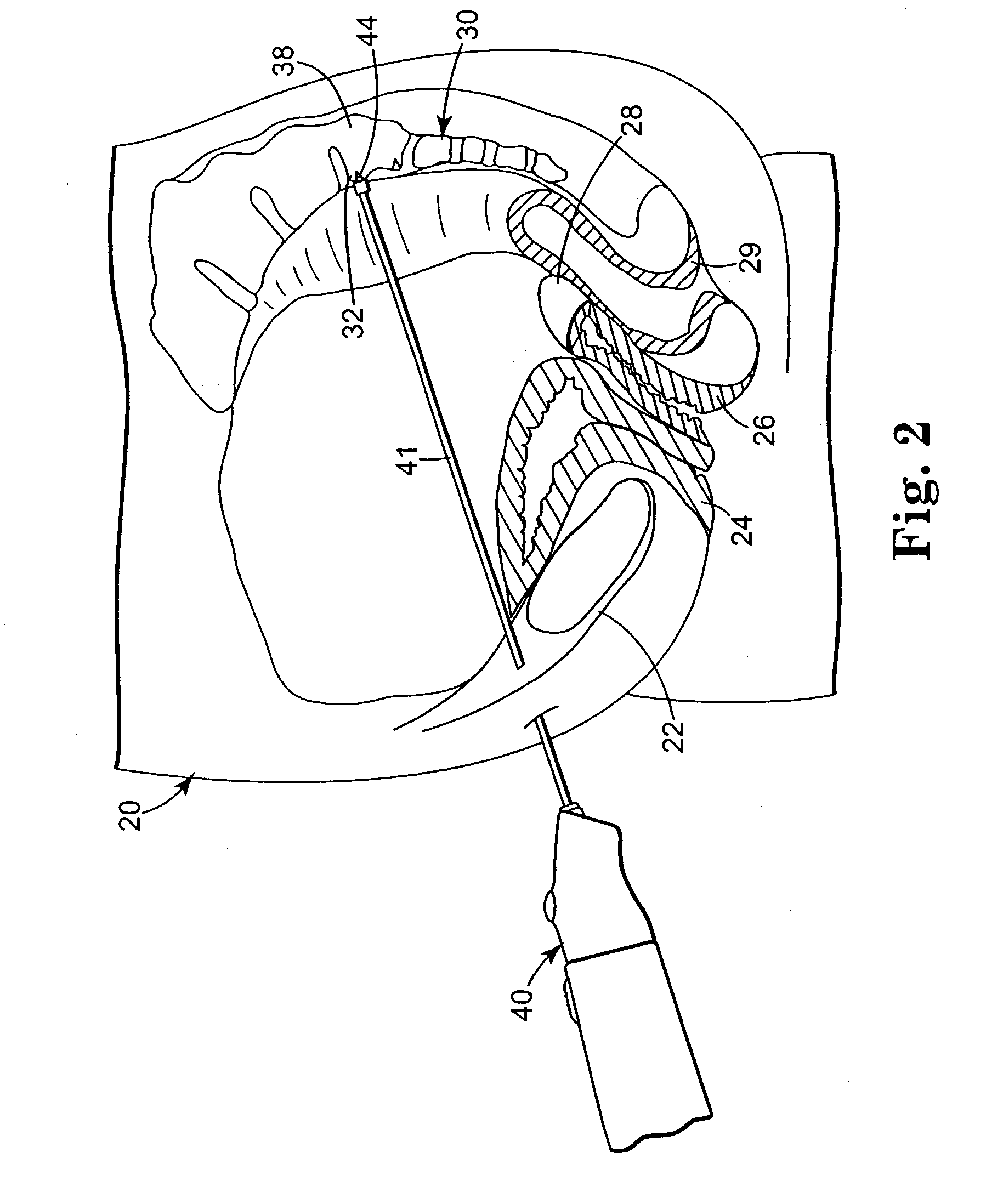Implantable article and method
a technology of implantable articles and mesh materials, applied in the field of preassembled implantable articles, can solve the problems of inability to fully fully inability to fully utilize the pelvis, etc., to achieve the effect of enhancing treatment effects, enhancing visibility, and encouraging tissue ingrowth
- Summary
- Abstract
- Description
- Claims
- Application Information
AI Technical Summary
Benefits of technology
Problems solved by technology
Method used
Image
Examples
example 1
[0097] Material and Method
[0098] The implantable article 10 is preferably constructed from a base or backing material, e.g. a tightly woven polyester mesh having a plurality of pores. The polyester mesh is ultimately coated with a silicone dispersion. The base material may be a Rashel knit mesh made from 150 dernier polyester yarn. In an uncoated state, the thickness may be between about 0.01 inches and about 0.04 inches, preferably about 0.020 inches (0.508 mm). The mesh has a hole size of approximately {fraction (1 / 32)}" (25.4 mm) and a weight of approximately 4.7 oz / yard (133.25 grams / 0.914 m) constructed from polyester or polypropylene. Preferably, the pore density is between 50 and 400 pores / square inch, more preferably about 240 pores per square inch. After coating, the size of the holes or pores is preferably in the range of about 0.040 inches (1.016 mm) to about 0.055 inches (1.397 mm).
[0099] The polyester material is coated with a silicone material (e.g. NuSil MED 6820, ava...
example 2
Construction
[0112] Referring to FIG. 8, the silicone coated material of Example 1 was cut into two rectangular components each having a width of about 38 to about 42 mm. The larger component 16C had a length of about 147.3 to about 152.4 mm. The smaller component 14C had a length between about 43 and about 45 mm.
[0113] The larger component 16C was placed on a flat fixture and the smaller component 14C was placed on top of it. The edges are even and substantially parallel as shown in FIG. 8.
[0114] A dispenser having two separate reservoirs, a static mixer, and nozzle 80 is positioned at the edge of the smaller component 14C as shown in FIG. 9. The components of the liquid silicone elastomer (e.g. MED-4840 LSR elastomer, generally available from NuSil) are loaded into the reservoirs.
[0115] The elastomer is placed at the edge of the short portion 14C so that it flows through the pores and provides a layer of elastomer at the top and bottom of the bond. Preferably, at least two full row...
example 3
[0117] FIG. 10 illustrates an example similar to that of Example 2, except that a recessed fixture 77 is used. The nozzle 75 may be used to press against the edge of the short portion 14C of the implant. This process may be manual or automated in whole or in part.
[0118] This example comprises a method of making an implantable surgical article comprising the steps of (1) providing a thin, first strip with first and second ends, major surfaces, and a length between the first and second ends; (2) providing a thin, second strip with first and second ends, major surfaces, and a length between the first and second ends; the length of the second strip being less than that of the first strip; (3) placing a major surface of the first strip against a major surface of the second strip; and (4) bonding the first strip to the second strip.
[0119] Preferably, the step of bonding the first strip to the second strip includes the step of bonding the first strip to the second strip with a silicone ela...
PUM
 Login to View More
Login to View More Abstract
Description
Claims
Application Information
 Login to View More
Login to View More - R&D
- Intellectual Property
- Life Sciences
- Materials
- Tech Scout
- Unparalleled Data Quality
- Higher Quality Content
- 60% Fewer Hallucinations
Browse by: Latest US Patents, China's latest patents, Technical Efficacy Thesaurus, Application Domain, Technology Topic, Popular Technical Reports.
© 2025 PatSnap. All rights reserved.Legal|Privacy policy|Modern Slavery Act Transparency Statement|Sitemap|About US| Contact US: help@patsnap.com



